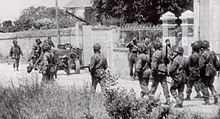
Operation Tonga was the codename given to the airborne operation undertaken by the British 6th Airborne Division between 5 June and 7 June 1944 as a part of Operation Overlord and the D-Day landings during the Second World War.
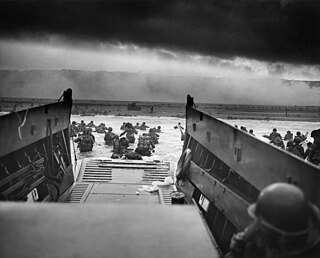
The Normandy landings were the landing operations and associated airborne operations on 6 June 1944 of the Allied invasion of Normandy in Operation Overlord during the Second World War. Codenamed Operation Neptune and often referred to as D-Day, it is the largest seaborne invasion in history. The operation began the liberation of France, and the rest of Western Europe, and laid the foundations of the Allied victory on the Western Front.
Operation Dingson was an operation in the Second World War, conducted by 178 Free French paratroops of the 4th Special Air Service (SAS), commanded by Colonel Pierre-Louis Bourgoin, who jumped into German occupied France near Vannes, Morbihan, Southern Brittany, in Plumelec, on the night of 5 June 1944 with Captain Pierre Marienne and 17 men, then advanced to Saint-Marcel.

Pegasus Bridge, originally called the Bénouville Bridge after the neighbouring village, is a road crossing over the Caen Canal, between Caen and Ouistreham in Normandy. The original bridge, built in 1934, is now a war memorial and is the centrepiece of the Memorial Pegasus museum at nearby Ranville. It was replaced in 1994 by a modern design which, like the old one, is a bascule bridge.

The Merville Gun Battery is a decommissioned coastal fortification in Normandy, France, which was built as part of the Germans' Atlantic Wall to defend continental Europe from Allied invasion. It was a particularly heavily fortified position and one of the first places to be attacked by Allied forces during the Normandy Landings commonly known as D-Day. A British force under the command of Lieutenant Colonel Terence Otway succeeded in capturing this position, suffering heavy casualties.

Lieutenant Herbert Denham Brotheridge was a British Army officer who served with the 2nd Battalion, Oxfordshire and Buckinghamshire Light Infantry during the Second World War. He is often considered to be the first Allied soldier to be killed in action on D-Day, 6 June 1944. He was killed during Operation Tonga: the British airborne landings which secured the left flank of the invasion area before the main assault on the Normandy beaches began.

Glider infantry was a type of airborne infantry in which soldiers and their equipment were inserted into enemy-controlled territory via military glider. Initially developed in the late 1930s by Germany, glider infantry units were used extensively during World War II but are no longer used by any modern military.

Lieutenant Colonel Terence Brandram Hastings Otway DSO, was an officer in the British Army, best known for his role as commander of the paratroop assault on the Merville Battery on D-Day.
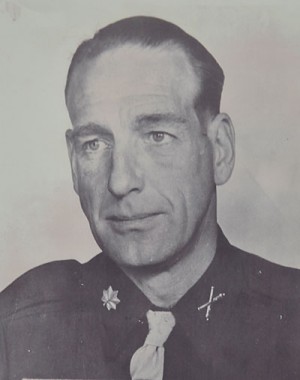
Brigadier General Don Forrester Pratt was a United States Army officer. He was the assistant division commander (ADC) of the 101st Airborne Division and was the highest-ranking Allied officer killed on D-Day.

The 1st Canadian Parachute Battalion was an airborne infantry battalion of the Canadian Army formed in July 1942 during the Second World War; it served in North West Europe, Landing in Normandy during Operation Tonga, in conjunction with the D-Day landings of 6 June 1944 and in the airborne assault crossing of the River Rhine, Operation Varsity, in March 1945. After the end of hostilities in Europe, the battalion was returned to Canada where it was disbanded on 30 September 1945.
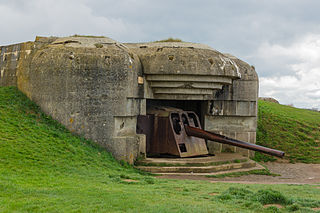
The Longues-sur-Mer battery is a World War II German coastal artillery battery approximately 1 km (0.62 mi) north of the village of Longues-sur-Mer in Normandy, France. The battery is sited on a 60 m (200 ft) cliff overlooking the Baie de Seine and formed a part of Germany's Atlantic Wall coastal fortifications, between the Allied landing sectors of Gold Beach and Omaha Beach.

The Bayeux War Cemetery is the largest Second World War cemetery of Commonwealth soldiers in France, located in Bayeux, Normandy. The cemetery contains 4,648 burials, mostly from the Invasion of Normandy. Opposite this cemetery stands the Bayeux Memorial which commemorates more than 1,800 casualties of the Commonwealth forces who died in Normandy and have no known grave.
Albert Richards was a British war artist. Born in 1919 to a World War I veteran, he enlisted as a sapper in 1940. He later served in the British Army during World War II, both as a paratrooper and as a war artist. He was the youngest of the three British official war artists killed during the conflict.
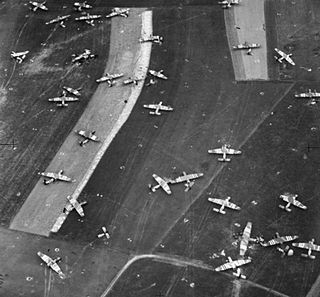
Operation Mallard was the codename for an airborne forces operation, which was conducted by the British Army on 6 June 1944, as part of the Normandy landings during the Second World War.

The capture of the Caen canal and Orne river bridges was an operation by airborne forces of the British Army that took place in the early hours of 6 June 1944 as part of the Normandy landings of the Second World War. The objective was to capture intact two road bridges in Normandy across the River Orne and the Caen canal, providing the only exit eastwards for British forces from their landing on Sword Beach. Intelligence reports said both bridges were heavily defended by the Germans and wired for demolition. Once captured, the bridges had to be held against any counter-attack, until the assault force was relieved by commandos and other infantry advancing from the landing beach.

The 9th Parachute Battalion was an airborne infantry battalion of the Parachute Regiment, raised by the British Army during the Second World War. The battalion was created in late 1942 by the conversion of the 10th Battalion, Essex Regiment to parachute duties. The battalion was assigned to the 3rd Parachute Brigade, alongside the 7th and 8th Parachute battalions, then part of the 1st Airborne Division but was later transferred to the 6th Airborne Division.

The Battle of Merville Gun Battery was a series of British assaults beginning 6 June 1944, as part of Operation Tonga, part of the Normandy landings, during the Second World War. Allied intelligence believed the Merville Gun Battery was composed of heavy-calibre 150 mm (5.9 in) guns that could threaten the British landings at Sword Beach, only 8 miles (13 km) away.
The Houlgate battery was a World War II German artillery battery constructed close to the French village of Houlgate in the Calvados department in the Lower Normandy region. Built into the top of a 300 ft (91 m) cliff, the bunker complex was created to protect the western bank of the mouth of the River Seine and was 10 mi (16 km) east of the Normandy landing beach Sword which it shelled. The former fire control post has been turned into an orientation table. The battery is 8 km west of the Mont Canisy battery.

The Antrim Fortress Royal Engineers was a coast defence unit of the UK's Territorial Army formed in Northern Ireland in the late 1930s. During World War II it was converted to a parachute role and dropped into Normandy on D Day and across the Rhine during Operation Varsity. Its successors continue in the Army Reserve today.
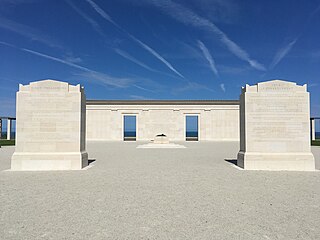
The British Normandy Memorial is a war memorial near the village of Ver-sur-Mer in Normandy, France. It was unveiled on 6 June 2021, the 77th anniversary of D-Day, and it is dedicated to soldiers who died under British command during the Normandy landings.

